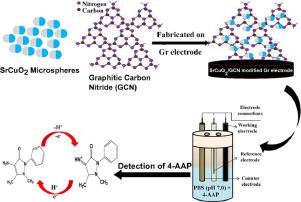当前位置:
X-MOL 学术
›
Surf. Interfaces
›
论文详情
Our official English website, www.x-mol.net, welcomes your
feedback! (Note: you will need to create a separate account there.)
Simple sonochemical synthesis of SrCuO2 assisted GCN Nanocomposite for the sensitive electrochemical detection of 4-AAP
Surfaces and Interfaces ( IF 5.7 ) Pub Date : 2020-09-01 , DOI: 10.1016/j.surfin.2020.100603 B.M. Sachith , S. Sandeep , S. Nandini , S. Nalini , C.S. Karthik , N. Kumara Swamy , P. Mallu , J.G. Manjunath
Surfaces and Interfaces ( IF 5.7 ) Pub Date : 2020-09-01 , DOI: 10.1016/j.surfin.2020.100603 B.M. Sachith , S. Sandeep , S. Nandini , S. Nalini , C.S. Karthik , N. Kumara Swamy , P. Mallu , J.G. Manjunath

|
Abstract The present study demonstrates the development of an electrochemical sensor to detect and quantify 4- Aminoantipyrene (4-AAP), using strontium copper oxide (SrCuO2) microspheres and graphitic carbon nitride (GCN) as a composite in the modified graphite electrode. The SrCuO2 is synthesized by sonochemical method and GCN was prepared using pyrolysis method. Field emission scanning electron microscopy (FESEM), X-ray diffraction spectroscopy (XRD) techniques are used in the characterization of the synthesized materials. Subsequently, the well characterized GCN and SrCuO2 are deposited onto a graphite (Gr) surface and used as transducer material in the fabrication of the electrode. Electrochemical characterization of the as fabricated electrode was carried out with the help of electrochemical impedance spectroscopy (EIS). The results validated the conducting nature of SrCuO2 and GCN. In Comparison with the unmodified electrode, the proposed Gr/SrCuO2/GCN electrochemical sensor, displayed enhanced electrocatalytic behavior towards 4-AAP. The sensor's analytical performance is calibrated and evaluated by cyclic voltammetry (CV) and Differential pulse voltammetry (DPV). The sensor exhibited exceptional characteristics like wide linear range, low detection limit. In addition, the proposed sensor also showed an excellent repeatability, good reproducibility and superior stability. Finally, the real sample analysis results indicated an acceptable recovery range that endeavored the use of the proposed sensor to monitor 4-AAP.
中文翻译:

SrCuO2 辅助 GCN 纳米复合材料的简单声化学合成用于 4-AAP 的灵敏电化学检测
摘要 本研究展示了使用氧化锶铜 (SrCuO2) 微球和石墨氮化碳 (GCN) 作为复合材料在改性石墨电极中检测和量化 4-氨基反芘 (4-AAP) 的电化学传感器的开发。SrCuO2采用声化学法合成,GCN采用热解法制备。场发射扫描电子显微镜 (FESEM)、X 射线衍射光谱 (XRD) 技术用于表征合成材料。随后,充分表征的 GCN 和 SrCuO2 沉积在石墨 (Gr) 表面上,并用作电极制造中的换能器材料。在电化学阻抗谱 (EIS) 的帮助下,对制成的电极进行电化学表征。结果验证了 SrCuO2 和 GCN 的导电性质。与未修饰的电极相比,所提出的 Gr/SrCuO2/GCN 电化学传感器对 4-AAP 显示出增强的电催化行为。传感器的分析性能通过循环伏安法 (CV) 和微分脉冲伏安法 (DPV) 进行校准和评估。该传感器具有线性范围宽、检测限低等特殊特性。此外,所提出的传感器还表现出优异的重复性、良好的再现性和卓越的稳定性。最后,实际样品分析结果表明可接受的回收范围,努力使用所提出的传感器来监测 4-AAP。对 4-AAP 显示出增强的电催化行为。传感器的分析性能通过循环伏安法 (CV) 和微分脉冲伏安法 (DPV) 进行校准和评估。该传感器具有线性范围宽、检测限低等特殊特性。此外,所提出的传感器还表现出优异的重复性、良好的再现性和卓越的稳定性。最后,实际样品分析结果表明可接受的回收范围,努力使用所提出的传感器来监测 4-AAP。对 4-AAP 显示出增强的电催化行为。传感器的分析性能通过循环伏安法 (CV) 和微分脉冲伏安法 (DPV) 进行校准和评估。该传感器具有线性范围宽、检测限低等特殊特性。此外,所提出的传感器还表现出优异的重复性、良好的再现性和卓越的稳定性。最后,实际样品分析结果表明可接受的回收范围,努力使用所提出的传感器来监测 4-AAP。所提出的传感器还表现出出色的重复性、良好的再现性和卓越的稳定性。最后,实际样品分析结果表明可接受的回收范围,努力使用所提出的传感器来监测 4-AAP。所提出的传感器还表现出出色的重复性、良好的再现性和卓越的稳定性。最后,实际样品分析结果表明可接受的回收范围,努力使用所提出的传感器来监测 4-AAP。
更新日期:2020-09-01
中文翻译:

SrCuO2 辅助 GCN 纳米复合材料的简单声化学合成用于 4-AAP 的灵敏电化学检测
摘要 本研究展示了使用氧化锶铜 (SrCuO2) 微球和石墨氮化碳 (GCN) 作为复合材料在改性石墨电极中检测和量化 4-氨基反芘 (4-AAP) 的电化学传感器的开发。SrCuO2采用声化学法合成,GCN采用热解法制备。场发射扫描电子显微镜 (FESEM)、X 射线衍射光谱 (XRD) 技术用于表征合成材料。随后,充分表征的 GCN 和 SrCuO2 沉积在石墨 (Gr) 表面上,并用作电极制造中的换能器材料。在电化学阻抗谱 (EIS) 的帮助下,对制成的电极进行电化学表征。结果验证了 SrCuO2 和 GCN 的导电性质。与未修饰的电极相比,所提出的 Gr/SrCuO2/GCN 电化学传感器对 4-AAP 显示出增强的电催化行为。传感器的分析性能通过循环伏安法 (CV) 和微分脉冲伏安法 (DPV) 进行校准和评估。该传感器具有线性范围宽、检测限低等特殊特性。此外,所提出的传感器还表现出优异的重复性、良好的再现性和卓越的稳定性。最后,实际样品分析结果表明可接受的回收范围,努力使用所提出的传感器来监测 4-AAP。对 4-AAP 显示出增强的电催化行为。传感器的分析性能通过循环伏安法 (CV) 和微分脉冲伏安法 (DPV) 进行校准和评估。该传感器具有线性范围宽、检测限低等特殊特性。此外,所提出的传感器还表现出优异的重复性、良好的再现性和卓越的稳定性。最后,实际样品分析结果表明可接受的回收范围,努力使用所提出的传感器来监测 4-AAP。对 4-AAP 显示出增强的电催化行为。传感器的分析性能通过循环伏安法 (CV) 和微分脉冲伏安法 (DPV) 进行校准和评估。该传感器具有线性范围宽、检测限低等特殊特性。此外,所提出的传感器还表现出优异的重复性、良好的再现性和卓越的稳定性。最后,实际样品分析结果表明可接受的回收范围,努力使用所提出的传感器来监测 4-AAP。所提出的传感器还表现出出色的重复性、良好的再现性和卓越的稳定性。最后,实际样品分析结果表明可接受的回收范围,努力使用所提出的传感器来监测 4-AAP。所提出的传感器还表现出出色的重复性、良好的再现性和卓越的稳定性。最后,实际样品分析结果表明可接受的回收范围,努力使用所提出的传感器来监测 4-AAP。











































 京公网安备 11010802027423号
京公网安备 11010802027423号